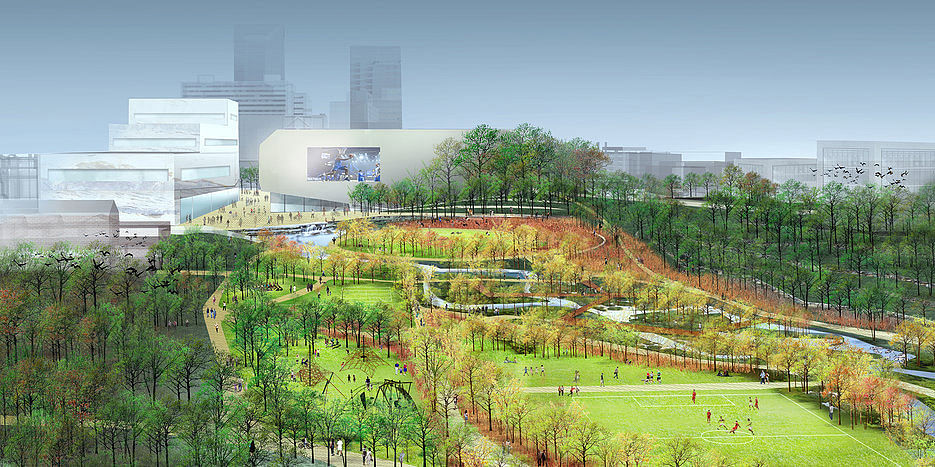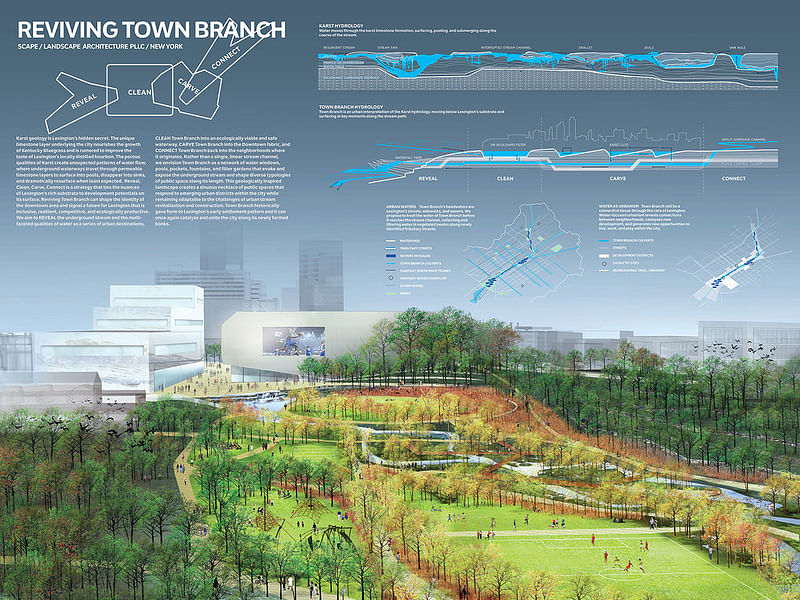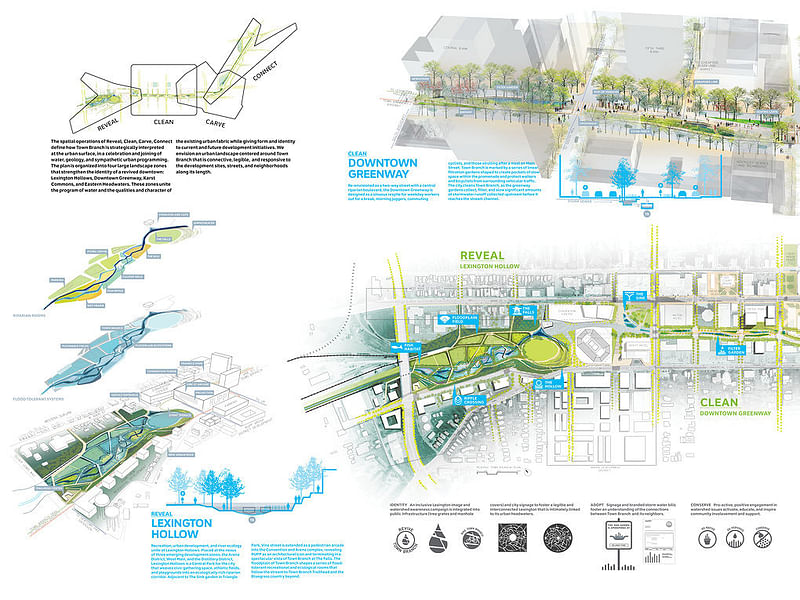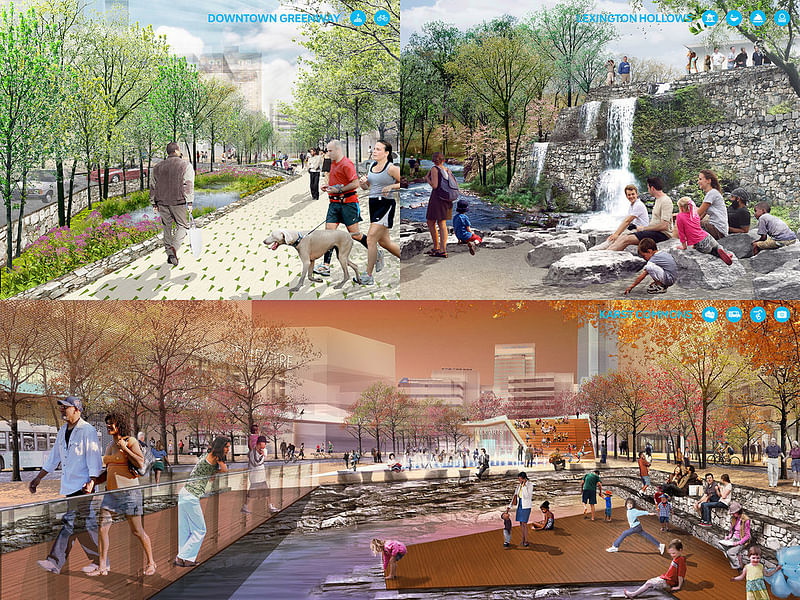SCAPE Wins Lexington Town Branch Commons Competition
By Bustler Editors|
Wednesday, Feb 6, 2013

Related
A five-member jury has selected the winner of the Town Branch Commons Design Competition in Lexington, Kentucky. The brief calls for the creation of a long, serpentine park following the path of a historic stream in downtown Lexington.
From a shortlist of five finalists, the entry "Reviving Town Branch" by SCAPE / Landscape Architecture team was chosen as the winning proposal. Other finalists were Coen+Partners, Minneapolis; Civitas, Denver; Inside Outside: Petra Blaisse, Amsterdam; and JDS / Julien De Smedt Architects, Copenhagen.
The jury included Aaron Betsky, Director Cincinnati Art Museum; Michael Speaks, Dean College of Design at the University of Kentucky; Bradford McKee, Editor-in-chief Landscape Architecture Magazine; Holly Wiedemann, Founder AU Associates, Inc.; and Ned Crankshaw, Chair Department of Landscape Architecture at the University of Kentucky.
All submitted designs are currently on display at City Gallery, Downtown Arts Center (141 East Main Street) through February 22 and will be displayed during the Gallery Hop on the 15th.
Project Description from SCAPE / Landscape Architecture:
Karst geology is Lexington’s hidden secret. The unique limestone layer underlying the city nourishes the growth of Kentucky Bluegrass and is rumored to improve the taste of Lexington’s locally distilled bourbon. The porous qualities of Karst create unexpected patterns of water flow, where underground waterways travel through permeable limestone layers to surface into pools, disappear into sinks, and dramatically resurface when least expected. Reveal, Clean, Carve, Connect is a strategy that ties the nuances of Lexington’s rich substrata to development potentials on its surface. Reviving Town Branch can shape the identity of the downtown area and signal a future for Lexington that is inclusive, resilient, competitive, and ecologically productive.
We aim to REVEAL the underground stream and the multi-faceted qualities of water as a series of urban destinations, CLEAN Town Branch into an ecologically viable and safe waterway, CARVE Town Branch into the Downtown fabric to stage its topographic qualities, and CONNECT Town Branch back into the neighborhoods where it originates. Rather than a single, linear stream channel, we envision Town Branch as a network of water windows, pools, pockets, fountains, and filter gardens that evoke and expose the underground stream and shape diverse typologies of public space along its length. Town Branch historically gave form to Lexington’s early settlement pattern and it can once again catalyze and unite the city along its newly formed banks.

Karst Geology as Placemaker
The geology of the Karst landscape and the emergent patterns of use Downtown have inspired our design. Just as in the natural hills and valleys around Lexington, water surfaces into pools, then disappears into ‘sinks’ to travel underground and unexpectedly ‘boil’ back up to the surface, the idea that Town Branch can surface and disappear again within the city fabric not only makes for a more feasible proposal, but it sparks difference and generates new places along its length that are deeply site specific and that magnify the existing urban districts that have emerged organically. Karst landscapes and their complex hydrology are the foundation of Lexington’s regional landscape, and are well suited in form and function to urban place-making and adaptable to the complex conditions of the urban underground. Vine Street in its current form is a linear infrastructural barrier that divides the city. Rather than creating additional linear barriers, we propose to use the pockets, pools, and water windows indigenous to Karst landscapes to re-shape the street, activating open space in the heart of the city. Rather than recreating a singular pre-colonial ecology, we propose to revive Town Branch as a series of diverse and resilient ecosystems local in character yet responsive to the needs of a 21st century city.

Landscape Infrastructure
Historically a waste canal, sewer, and water conduit for the city, Town Branch is a neglected, hidden, and under utilized fragment of public infrastructure. Reviving Town Branch can catalyze the redesign of other single-use infrastructures in Downtown Lexington, introducing the public realm as a critical element within the city’s traffic and water distribution networks. Vine Street, currently a one-way vehicular thoroughfare with sparse pedestrian presence, can be converted to a two-way street with slower and safer traffic, room for alternative modes of transportation, and space to filter Town Branch water’s along its spine. The city-wide two-way conversion plan is enabled by the Newtown Pike Extension, relieving traffic pressure on Vine and Main Streets.
The waters of Town Branch offer further opportunity to remake Lexington’s public realm. Originating in the streets and sidewalks of the city, Town Branch water will be collected in small pools along the stream path and filtered by vegetation, boosting the water volume of the small stream, removing urban contaminants that degrade downstream ecologies, and shaping a series of responsive public spaces. At the watershed scale, a program of newly identified Tributary Streets are targeted for green infrastructure upgrades, and work in tandem with the Remedial Measures Plan to reduce peak flows of storm water and sewage into Town Branch. The Town Branch Awareness Campaign excites Lexington citizens who have long forgotten the underground stream, reminding residents that the waters (and fate) of Town Branch exists in their backyards. This branding and marketing approach taps into national initiatives and fund raising efforts centered on a new celebration of urban water as restorative, healthy, and valued.

Project Framework
Lexington has many enviable urban features – a vigorous economy, a dynamic Main Street, a vibrant and internationally celebrated local culture, strong academic institutions, and diverse residential neighborhoods within walking distance of Downtown. Reviving Town Branch links these successes through the formation of a legible public space network that offers new ways to live, work, and play within the city. The spatial operations of “reveal, clean, carve, connect” define how Town Branch is interpreted at the urban surface and organize it into four memorable landscape zones: Lexington Hollows, Downtown Greenway, Karst Commons, and Eastern Headwaters. This spatial sequence brings together a distinct ‘revealed’ form of the water together with a specific urban context, giving form and identity to future development initiatives.

REVEAL / Lexington Hollows
Recreation, urban development, and river ecology unite at Lexington Hollows. Placed at the nexus of three emerging development zones, the Arena District, West Main, and the Distillery District, Lexington Hollows is a Central Park for the city that weaves civic gathering space, athletic fields, and playgrounds into an ecologically rich riparian corridor. The Hollows is a place to celebrate the pride of the city, the beloved University of Kentucky Wildcats, on game day and throughout the year. The convention center is expanded vertically and exposes Rupp Arena as an architectural icon within the city fabric. Logistical and service entrances are layered below an occupiable outdoor event terrace. The western end of Vine Street is extended as a pedestrian arcade featuring retail and dining, starting with The Sink garden at Triangle Park and culminating in the dramatic reveal of Town Branch at The Falls.
Wildcat fans, Convention goers and the public alike can collect on the event terrace and soft lawn amphitheater of the Hollows to watch projected highlights of the basketball games, and on non-game weekends, evening movies with family and friends. Looking west, with the Jefferson Street overpass removed, an expansive view is revealed of the sinuous path of Town Branch as it unfolds towards the trailhead of Town Branch Trail and Bluegrass Country beyond. Descending into the Hollows along the curving amphitheater path, spaces for birdwatchers, children, soccer players and youth basketball practice unfold within the scrim of riparian trees that line the brook’s edge. Recreational and habitat rooms protect adjacent development from flood risk while serving the recreational needs of the city. Old culvert infrastructure is re-cast as public space and integrated into the heart of the stream channel as bridge crossings and overlooks. Lexington Hollows showcases the region’s ecology alongside its renowned athletics, creating a green heart within the city.
Whether Town Branch water is revealed or remains underground, its path is clearly marked as it weaves in and out of the city’s fabric. Paving, planting, and structural elements form a material palette that evokes the underground stream. A linear paver is developed with varying degrees of porosity that reflects the porous qualities of Karst limestone while allowing water to infiltrate into the stream channel below. Flood tolerant trees are planted in thin hedgerows to evoke the feel of a riparian forest edge, while remaining tolerant to the low-oxygen conditions of the urban streetscape. Stone fences, prominent in the rural Bluegrass Country, are extended downtown and provide places to sit and lounge while protecting pedestrians from vehicular traffic. Our plan’s approach to materials enlivens and synthesizes the landscape of Vine street along its length, culminating in a central plaza at Rupp Arena and the Falls through not only physical connection and landscape spaces, but by integrating night-time lighting and a dynamic projections on the “Hollows” side of Rupp, promoting a greater sense of security, more feet on the street during evening hours, and ultimately increased economic activity and vitality. An investment in the design and materiality of Town Branch will unlock value along its edges.
CLEAN / Downtown Greenway
Re-envisioned as a two-way street with a central riparian boulevard, Vine Street’s Downtown Greenway is designed as a sinuous respite for weekday workers out for a break, morning joggers, commuting cyclists, and those strolling after a meal on Main Street. Town Branch is re-cast as hybrid hydrological and urban infrastructure, creating defined and safe spaces for water, pedestrians, bicyclists, and vehicles along its path. The water’s path is marked with a series of linear filtration gardens shaped to create pockets of slow space within the promenade and protect walkers and bicyclists from surrounding vehicular traffic. The city cleans Town Branch, as the greenway gardens collect, filter, and slow significant amounts of stormwater runoff collected upstream before it reaches the stream channel. Vine Street is transformed into a green complement to Main Street, and becomes a destination for early risers out to walk their dogs, an outdoor market space for art fairs and food festivals, and a pleasant shortcut for downtown bankers lunching at Cheapside Plaza. New development sites, including Center Pointe and the southern parcel of Phoenix Park, are designed to connect to and activate the Greenway, while helping fund its development through public-private partnerships. Greater numbers of pedestrians will move through the downtown district during longer periods of the day and evening, which translates into increased economic activity, more profitable businesses, and over time, higher achievable rents and higher property values.
CARVE / Karst Commons
New water-based public spaces are strategically carved into Lexington’s emerging arts and entertainment district, catalyzing development of vacant sites downtown and expanding amenities for urban living. Renovation of the MLK Boulevard overpass as a pedestrian way creates a layered common space that attracts activity from surrounding streets and refocuses existing theater, arts, and entertainment programs around a central urban plaza and ‘stage.’ The design of this zone in particular accommodates opportunities to imbed revenue-generating concessions like a café, bike rental shop that can vary by season, time of day, special event, and location. These concessions can provide new sources of sustained revenue to support appropriate levels of maintenance, operations, and capital replacement for the park’s long term success. Spatially, Town Branch emerges, disappears, and re-emerges as karst cuts and designed rock formations, creating larger windows for dynamic play, performance, and entertainment while orienting one to the underground stream below. Outdoor spaces are programmed by established and emerging cultural venues, as Karst Commons is a destination for those looking to browse the LexArts pop-up gallery, swing dance groups taking advantage of the open space and audience, and Kentucky Theater- lovers looking to linger after an evening performance, extending activity to longer periods of the day and evening. Water windows shape multifunctional spaces for relaxation and entertainment throughout the day, whether to park a bicycle and grab a morning coffee, meet up for a game of chess before catching the bus home, or take the kids out for a Saturday afternoon fountain frolic at The Boils. Our signature paving pattern – more permeable in planted and water based zones - stretches across and compresses to support active movement, linking the Commons to the more linear boulevard at the Downtown Greenway.
CONNECT / Eastern Headwaters
Rather than being fed by a single source, Town Branch waters come from a broad field of neighborhoods in Lexington’s northeast. Likewise, the Eastern Headwaters branches out to actively bring people from headwater neighborhoods towards the stream path and towards each other. Currently divided by rail and highway infrastructure, the revealed Town Branch provides a connective riparian tissue that links these diverse communities along a revitalized neighborhood corridor. New low-rise, mixed use development integrates into the existing residential fabric adjacent to Midland Avenue, reconfigured as a blue street, with parking lanes, a thick riparian buffer, protective stone fence, and the trickling path of Town Branch. East End and Bell Court residents benefit from Midland as a neighborhood destination, whether to pick up some produce at the headwaters community garden, take a walk downtown, or cross over to the Charles Young recreational fields for a game of pickup football. The divisive railway is re-purposed as a connective bikeway, linking headwater residents across Midland Avenue, into downtown, and to the broader region along the 3rd Street Legacy Trail extension. The Isaac Murphy Memorial Arts Garden becomes the gateway to Town Branch, drawing curious tourists eager to learn about the history of the city and adventurous cyclists determined to complete the Legacy Trail.
Our vision is inclusive, and the headwaters reach out to build upon the planning and design initiatives of Lexington’s underserved neighborhoods and constituents.
The SCAPE team brings together national and local leaders in the fields of urban landscape design, ecology, planning, community engagement, graphic design and economic development. At the core of Reviving Town Branch is the creation of a signature urban open space, and although we may work with multiple architecture and development teams for different parcels, a strong landscape architecture vision and disciplinary expertise is required to lead and coordinate this effort. SHERWOOD DESIGN ENGINEERS is a key consultant and brings civil and environmental engineers and ecologists to this effort, with experience in integrating hydrology in natural and urban water systems. MTWTF brings a signature sense of openness and interactivity to their branding, signage, and identity work. Their role will be key in re-figuring the revitalized Town Branch in to the consciousness of Lexington citizens. JAMES LIMA has valuable experience bridging public realm improvements and private initiatives with catalytic economic effects, and knows the demonstrated value of improving the performance, competitiveness and economic vitality of these urban centers with landscape design. Finally, EHI Consultants brings a wealth of broad planning and design experience, a deep and specific local knowledge of the site, an understanding of the local development frameworks and how to implement Town Branch over time, and a broader sense of community, place, and inclusivity that has inspired our work and will propel this project towards a successful realization.

Share
0 Comments
Comment as :